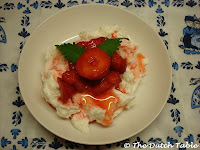 |
| Market sign announcing the "one and only" Van Dobben Kroket on a roll |
The most popular posts on this blog tend to be either sandwich-related or fast-food related: the broodjes post scores high, as well as the bitterballen and the frikandellen posts. The latter scores high on a list of its own, the Top Ten of Favorite Snacks (http://snacks.toptien.nl/), and is closely followed by the ultimate deep-fried gravy stick, the meat kroket.
Companies such as Van Dobben and Kwekkeboom, both food establishments in Amsterdam, are famous for their meat kroketten and have been offering this fried delicacy since the mid 1940s. Each has their own following, and discussions about which kroket is superior is ongoing. Patisserie Holtkamp, one of the more sophisticated baked goods shops around town, also showcases kroketten, or in their case, croquetten, but has embraced a more varied flavor assortment: veal, cheese, sweetbreads/truffle and lobster. The Holtkamp shrimp croquet is their best-selling item.
 |
| Holtkamp's Shrimp Croquet |
The cookbook from the Amsterdam Home Economics School, Kookboek van de Amsterdamse Huishoudschool, in its tenth edition from the 1940s, mentions a variety of croquetten: meat but also potato and shrimp, fish, sweetbreads, cheese and even macaroni. The spelling was fancier (the "c" and "q" were replaced by the more common "k" in later years) which also implied a more sophisticated presentation: according to the book, croquetten were to be deep-fried until golden, stacked in a pyramid-shape and served on a starched napkin with fried parsley for decoration.
Wow. Well, nowadays the meat kroket is usually served in a less charming manner: in a triangular paper cone or simply out of the wall on a paper tray, with no fried parsley or starched napkin in sight. And you'll be hard pressed to find a sweetbread kroket or a macaroni kroket in any of the establishments for supplying fatty foods such as the neighborhood snackbars or Febos.
But let that not stop us! Today we're making meat kroketten. The meat was first used to draw a beef stock for a vegetable soup, then shredded. You can also use leftover roast beef. If all you have is a pound of raw chuck roast or some other simmer meat, place the meat in a saucepan, add eight cups of water, half an onion, two peeled carrots and two chopped sticks of celery. Bring to a boil, then cover and simmer for two hours. Skim the broth, discard the vegetables and cool the meat.
Make sure you bread the kroket on all sides: one small crack and the filling will spill out into the fryer and cause a mess. You can also use this mixture for bitterballen. Once you get the hang of it, experiment with your own flavors. Leftover bbq beef? Go for it. A vegetarian version with a mushroom medley? Awesome! Just because Kwekkeboom, Holtkamp and Van Dobben come up with all kinds of flavors, doesn't mean you can't :-)
Kroketten
1 lb (450 grams) beef, cooked and chilled
1 cup (250 ml) milk or beef bouillon
6 tablespoons flour
1 tablespoon chopped parsley
1/8 teaspoon dried thyme
1/4 teaspoon ground black pepper
1/2 teaspoon salt
2 tablespoons (30 grams) butter
2 eggs
1 cup panko or breadcrumbs
Shred the cooked meat and chop fine in a food processor, or by hand. Melt the butter in a pan, and stir in the flour. When the flour has soaked up all the fat, slowly pour in the milk or bouillon while continuing to stir. The flour will thicken the liquid and turn into a thick, creamy gravy. Stir at least one or two more minutes after the sauce has come together to get rid of some of the flour taste. Now add the tablespoon of chopped parsley, the pinch of pepper and salt and finally stir in the chopped meat. If the gravy is too thin, add another tablespoon of flour. Too thick? Carefully add a tablespoon of milk or broth to the mix and stir.
Spread this meaty mix on a baking sheet or a shallow plate, let it cool for about thirty minutes, then wrap and refrigerate it overnight.
Remove the roux from the fridge. Sprinkle some flour on the counter, divide the mixture into six equal pieces and roll each piece through the flour. Shape into tight logs, approximately 4 inches long and 1 inch wide. Your main concern will be to have kroketten approximately the same size. Wrap and refrigerate, while you prepare the rest.
Place three deep plates in a row. In the first one, put flour, the second one 2 beaten eggs, the third one, one cup of panko or breadcrumbs. Take the kroketten out of the fridge. With your dominant hand, lightly roll the kroket in the flour, then through the egg (make sure you cover the whole surface!) and finally through the breadcrumbs. Check to see that each area of the log is covered. Set aside while you repeat with the rest of the kroketten. Wrap and refrigerate while you heat up the oil.
Heat your fryer oil up to 375F. When it's ready, place one or two kroketten at a time in the hot oil and fry them until golden. This will take anywhere from 3-5 minutes. Take them out of the oil and let them drain on a couple of paper towels to get some of the fat off.
Serve hot. With or without fried parsley or a starched napkin, but do not forget the mustard!














